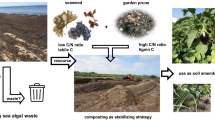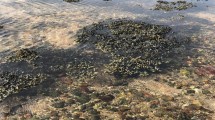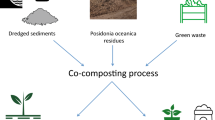Abstract
The sea contains large amounts of resources that are sometimes considered as waste. Such material includes the waste generated by the fish-processing industry and seaweed that is washed up on shores. In this study, these waste products were windrow composted, along with pine bark as a source of carbon and aeration. The final mix proportions were 20 % seaweed, 20 % fish waste, and 60 % pine bark (v/v). After 10 weeks, stable, well-structured, hygienic compost, which was rich in organic matter and nutrients and had a low metal content, was obtained. Tests for maturity, hygiene, and phytotoxicity, along with a detailed physical and chemical characterization, showed that this compost can be used as an organic amendment and/or growth substrate for use in ecological agriculture. The only limiting feature was the high salinity, which could easily be lowered prior to composting the material.


Similar content being viewed by others
References
Abad M, Martínez-Herrero PF, Martínez-García MD, Martínez-Corts J (1992) Evaluación agronómica de los sustratos de cultivo. Actas Hortic 11:141–154
Abad M, Noguera P, Burés S (2001) National inventory of organic wastes for use as growing media for ornamental potted plant production: case study in Spain. Bioresour Technol 77:197–200
AENOR (2001) Normas UNE-EN 13037, 13038, 13039, 13040, 13041
Arvanitoyannis IS, Kassaveti A (2008) Fish industry waste: treatments environmental impacts current and potential uses. Int J Food Sci Tech 43:726–745
Blunden G (1991) Agricultural uses of seaweed and seaweed products. In: Guiry MD, Blunden G (eds) European seaweed resources: uses and potential. Wiley, Chichester, pp 65–81
Brinton WF, Evans E, Droffner ML, Brinton RB (1995) A standardized Dewar test for evaluation of compost self-heating. Biocycle 36:1–16
Chapman H, Pratt PF (1997) Métodos e análisis para suelos plantas y aguas. Editorial Trillas, Mexico City
Day M, Shaw K, Stofella P, Kahn B (2001) Biological chemical and physical processes of composting compost utilization. In: Stoffella PJ, Kahn BA (eds) Horticultural cropping systems. Lewis, Boca Raton, pp 17–50
De Boodt M, Verdonck O, Cappaert I (1974) Method for measuring the water release curve of organic substrates. Acta Hortic 37:2054–2063
EC Council 799/2006 (2006) Commission Decision 799/2006 establishing revised ecological criteria and the related assessment and verification requirements for the award of the community eco-label to soil improvers. Off J Eur Communities L325:38–34
EC Council 64/2006 (2006) Commission Decision 64/2006 establishing revised ecological criteria and the related assessment and verification requirements for the award of the community eco-label to growing media. Off J Eur Communities L32:137–143
EC Council 834/2007 (2007) Regulation 834/2007 of 28 June 2007 on organic production and labelling of organic products. Off J Eur Communities 189:1–23
EC Council 889/2008 (2008) Commission Regulation 889/2008 laying down detailed rules for the implementation of Council Regulation (EC) No 834/2007 on organic production and labelling of organic products with regard to organic production, labelling and control. Off J Eur Communities 250:1–84
EC Council 1069/2009 (2009) Regulation 1069/2009 of 21 October 2009 laying down health rules as regards animal by-products and derived products not intended for human consumption. Off J Eur Communities 300:1–33
Eyras MC, Sar EA (2003) Arribazones estivales en Puerto Madryn Argentina como Materiales para la Obtención de Compost. Bol Soc Argent Bot 38:105–111
Felipó M, Verdonck O, Cappaert I, De Boodt M (1979) Estudio de las propiedades físicas de los sustratos hortícolas. An Edafol Agrobiol 38:603–611
IFN3 (1997–2007) Tercer Inventario Forestal Nacional. Ministerio de Agricultura Alimentación y Medio Ambiente MAGRAMA. Available at http://www.magrama.gob.es/es/biodiversidad/servicios/banco-datos-naturaleza/informacion-disponible/ifn3.aspx
Jhorar B, Phogat V, Malik R (1991) Kinetics of composting rice straw with glue waste at different carbon: nitrogen ratios in a semiarid environment. Arid Land Res Manag 5:297–306
Liao PH, Jones L, Lau AK, Walkemeyer S, Egan B, Holbek N (1997) Composting of fish wastes in a full-scale in-vessel system. Bioresour Technol 59:163–168
López-Mosquera ME, Fernández-Lema E, Villares R, Corral R, Alonso B, Blanco C (2011) Composting fish waste and seaweed to produce a fertilizer for use in organic agriculture. Proc Environ Sci 9:113–117
MAGRAMA (2011) Anuario de Estadística 2010. Ministerio de Medio Ambiente Medio Rural y Marino (MARM)
Morand P, Briand X (1996) Excessive growth of macroalgae: a symptom of environmental disturbance. Bot Mar 39:491–516
Noguera P, Abad M, Puchades R, Maquieira A, Noguera V (2003) Influence of particle size on physical and chemical properties of coconut coir dust as container medium. Commun Soil Sci Plant Anal 34:593–605
RD 1110/1991 (1991) Real Decreto 1110/1991 de 12 de julio por el que se aprueban los métodos oficiales de análisis de productos orgánicos fertilizantes. Boletín Oficial del Estado 170:23725–23730
RD 824/2005 (2005) Real Decreto 824/2005 de 8 de julio sobre productos fertilizantes. Boletín Oficial del Estado 171:25592–25669, Amended by Orden APA 863/2008
RD 865/2010 (2010) Real Decreto 865/2010 de 14 de julio sobre sustratos de cultivo. Boletín Oficial del Estado 171:25592–25669
Sánchez-Monedero M, Roig A, Paredes C, Bernal M (2001) Nitrogen transformation during organic waste composting by the Rutgers system and its effects on pH EC and maturity of the composting mixtures. Bioresour Technol 78:301–308
Soliva M, López M, Huerta O, Valero J, Felipó M (2004) Waste organic matter quality versus soil amendment effects. In: Bernal MP, Moral R, Clemente R, Paredes C (eds) Sustainable organic waste management for environmental protection and food safety. Proceedings of 11th International Conference of the FAO ESCORENA Network on Recycling of Agricultural Municipal and Industrial Residues in Agriculture, RAMIRAN, Spain, pp 201–203
Thomas R, Sheard R, Moyer J (1967) Comparison of conventional and automated procedures for nitrogen phosphorus and potassium analysis of plant material using a single digestion. Agron J 59:240–243
Europea U (2012) La política pesquera común en cifras Información estadística básica. Comisión Europea Bélgica. doi:102771-19319
USDA Forest Service (1971) Bark and its possible uses. US Department of Agriculture Forest Service, Forest Products Laboratory, Madison
US Environmental Protection Agency (USEPA) (1993) Standards for the use or disposal of sewage sludge. Fed Reg 58:9248–9415
Villares R, Carral E, Lorenzana F, Mosquera ME (2007) Drift-seaweed evaluation for fertilizer use in Galiza (Northwest Spain): tissue elemental characterization and site-sampling differences. J Sustain Agric 31:45–60
Willer H, Kilcher L (2011) The world of organic agriculture: statistics and emerging trends 2011. International Federation of Organic Agriculture Movements (IFOAM), Bonn; Research Institute of Organic Agriculture (FiBL), Frick Switzerland
Zemke-White WL, Ohno M (1999) World seaweed utilisation: an end-of-century summary. J Appl Phycol 11:369–376
Zucconi F, Forte M, Monaco A, De Bertoldi M (1981) Biological evaluation of compost maturity. Biocycle 22:27–29
Acknowledgments
The authors are grateful to the Xunta de Galicia for funding this study (Projects PGIDT05TAM097E and 09MRU016291PR) and for the postgraduate grant awarded to Marta Illera-Vives. They also thank Pescados Rubén S.L. for supplying some of the materials used to produce the composts and for their helpful collaboration throughout the project. Finally, the authors thank the laboratory technician Rafael Corral Bellas for his meticulous laboratory assistance.
Author information
Authors and Affiliations
Corresponding author
Rights and permissions
About this article
Cite this article
Illera-Vives, M., Seoane Labandeira, S. & López-Mosquera, M.E. Production of compost from marine waste: evaluation of the product for use in ecological agriculture. J Appl Phycol 25, 1395–1403 (2013). https://doi.org/10.1007/s10811-013-9997-3
Received:
Revised:
Accepted:
Published:
Issue Date:
DOI: https://doi.org/10.1007/s10811-013-9997-3




